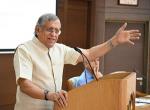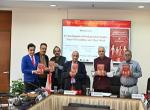On June 12, the Vivekananda International Foundation (VIF) organized a talk on 'The Story of Indian Warfare' based on the book 'India’s Battlefields from Kurukshetra to Balakot' written by Col. Ajay Singh (Retd), an author of seven books. He is the recipient of the Rabindranath Tagore International Award for Art and Literature 2022 and the Bharat Literary Award 2023. Dr. Arvind Gupta, Director, VIF, delivered the opening remarks in which he briefly talked about India’s remarkable military history and the various regional literature that is available on it. He also highlighted the lack of interest in the study of military history, which creates a disconnect with the past.
This was followed by a comprehensive talk by Col. Ajay Singh (Retd) on the story of Indian warfare. Indian civilization has seen many battles that have shaped the history of India and the destiny of its people. He talked about the Mahabharata and the 18-day battle that took place in Kurukshetra. This epic battle shaped Indian psyche as none other. For centuries thereafter, India adhered to the principles of righteousness and fighting a just war. Perhaps that is one of the reasons India has never been an aggressive expansionist nation.
In his talk, he focused largely on the battles fought between Indian rulers and outsiders. The first of these was the battle between the King of Pauravas (Porus) and Alexander on the banks of the Jhelum River in 326 BCE. In a day-long battle, the Indians fought the Greeks to a standstill and even broke their formidable phalanx, something that had never been done before. It is significant that after this battle, Alexander's troops refused to go further, and Alexander had to withdraw from India, calling the Indians the bravest and the most skilled opponent he had ever encountered.
The centuries that followed in the first millennia were the golden age of India, but it is an era that is unfortunately forgotten and considered a lost millennium. Empires like the Guptas, the Cholas, the Rashtrakutas, and the Pallavas all flourished. Indian rulers repeatedly repelled foreign invasions from Huns, Kushans, and Shakas and kept the continent safe and secure, making it the most prosperous civilization of that time.
The turning point came with the arrival of Arabs in Sindh in the 8th century CE. The prolonged Arab invasion spanning over 80 years resulted in the end of Hindu rule in Sindh. This was followed by the defeat of Prithviraj Chauhan in 1192 CE in the Second Battle of Tarain by Muhammad Ghori. Earlier, in the First Battle of Tarain, Prithviraj Chauhan defeated Ghori but couldn’t completely annihilate the invaders. After the Rajput defeat of 1192 CE, the Delhi Sultanate was established in India. Since then, it has been foreign rulers who have sat on the throne of Delhi till 1947.
An even more lasting change came about in 1526 CE, when Babur, armed with newly discovered cannons and muskets, defeated Ibrahim Lodi in the First Battle of Panipat. Babur later defeated the Rajputs under Rana Sanga in the Battle of Khanwa in 1527 CE. The Indians could not adapt to the new concepts of gunpowder and manoeuvre. This set the tone for the Mughal Empire in India, which then lasted 300 years. But Indian rulers continued to resist the Mughals in different parts of India, like Maharana Pratap of Mewar, the Ahoms in Assam, and Chhatrapati Shivaji in Deccan. The Battle of Haldighati and the Battle of Saraighat are prime examples of Indian resistance against the Mughals.
He talked about Chhatrapati Shivaji, who in the 17th century CE carved out the Maratha Empire in the Deccan, defeating the Nizams of Hyderabad and the Mughal armies. His legacy was carried forward by the Peshwas, especially Baji Rao I, who remained undefeated in 40 battles as the Marathas established their footprint from Kandahar to Kolkata on the strength of their light, fast cavalry. But the gradual rise of the Marathas was followed by an abrupt fall with the Third Battle of Panipat in 1761 CE.
Ahmad Shah Abdali, the Afghan ruler of Kabul, was invited by the Nawab of Awadh and the Rohillas to come to India and wade a Jihad against the Marathas. The stage was set for the largest and bloodiest battle in Indian history, the Third Battle of Panipat. The Marathas were very successful at the start of the campaign and even captured Delhi by the end of 1760. They then set out for Panipat, but Abdali crossed the Yamuna River and came up behind them, cutting them off from their supplies and replenishments. Starved in the cold North Indian winter, the Marathas gradually weakened. Finally, on 14th January 1761, on the auspicious day of Makar Sankranti, the Marathas launched a final desperate attack on the Afghan. All day long, the battle hung in balance, till the Maratha ranks finally broke late in the evening. In the slaughter that followed, over 30,000 Maratha warriors perished, and over 30,000 women and children were taken prisoner in what was the darkest day of Indian history. The Maratha defeat had an even greater consequence. It opened the way for the British to establish the empire by their victories in the battles of Palashi (1757) and Buxar (1764).
The Battle of Palashi was won by the British with the help of treachery. The British bribed Mir Zafar, the Commander-in-Chief of the Army, to betray his own ruler, which resulted in the establishment of British rule in India. The British further consolidated their position in India by turning Indian rulers against each other. First, they enlisted the Marathas and the Nawab of Hyderabad to help them in the Mysore war against Tipu Sultan. Then, they turned the Nizam and the Marathas against each other, using race and religion skillfully. In North India, the Sikhs under Maharaja Ranjit Singh had established an empire extending from Kandahar, right to Ladakh and Tibet. They used Indian soldiers to bring down the Sikh Empire in the Anglo-Sikh Wars. Later, they used the Sikh soldiers to quell the revolting sepoys of the British Bengal Army. Col. Ajay Singh stated that the British did not conquer India; they merely let us defeat ourselves. In the 190 years of British rule, India was reduced to under 1 percent of the world’s GDP from 23 percent in the mid-18th century. The British also used millions of Indian soldiers in the two world wars as cannon fodder and artificially induced famines in Bengal that further killed millions of people.
The story of Indian warfare continued after the independence in 1947. India was pushed towards a war just months after independence in 1947 in Jammu and Kashmir. The Indian army flew in just in time to repel the Pakistani raiders at the outskirts of Srinagar, but a significant part of Jammu and Kashmir remained illegally occupied by the Pakistanis. In 1962, India lost the India-China war, in which India lost Aksai Chin to China along with other smaller territories. In 1965, Indian troops marched towards Lahore, which turned the fortunes of the war in favour of India. India’s moment of reckoning came in 1971 with the liberation of Bangladesh from Pakistan. After 13 days of military action, 93,000 Pakistani soldiers surrendered at Dhaka and Indian forces were able to carve out a new nation.
Col. Ajay Singh’s book 'India’s Battlefields from Kurukshetra to Balakot' covers 42 of India’s major battles spanning 3000 years. The book brings out Indian war fighting over the centuries and provides a broad overview of Indian history itself. It provides unknown facets of India’s battles and presents them in a balanced, objective manner, giving insights and lessons that are applicable even today. This was accompanied by an engaging discussion. The session ended with concluding remarks and a vote of thanks by Dr. Arvind Gupta.








Post new comment